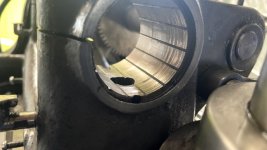Hello all
This is my 2nd post and what seems to be a common issue.
I replaced my slippery stretched leather drive belt on my 9C and found my bearings not looking to good along with bad felts and their springs.
Photos attached.
Is this a bad case of damaged bearing?


Getting the shaft cleaned up is easy enough.
I would like to do the best job I can repairing it as these old lathes are not cheap here in New Zealand.
I believe it is an old Education Department lathe so would have had a hard life at school metal work classes.
New felts kit on the way so just got to make the best of the headstock and spindle.
Shims look like they are made out of aluminium sheet, are they normally?
Easy enough to make though
Thanks
Adrian
This is my 2nd post and what seems to be a common issue.
I replaced my slippery stretched leather drive belt on my 9C and found my bearings not looking to good along with bad felts and their springs.
Photos attached.
Is this a bad case of damaged bearing?


Getting the shaft cleaned up is easy enough.
I would like to do the best job I can repairing it as these old lathes are not cheap here in New Zealand.
I believe it is an old Education Department lathe so would have had a hard life at school metal work classes.
New felts kit on the way so just got to make the best of the headstock and spindle.
Shims look like they are made out of aluminium sheet, are they normally?
Easy enough to make though
Thanks
Adrian


